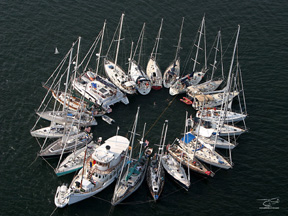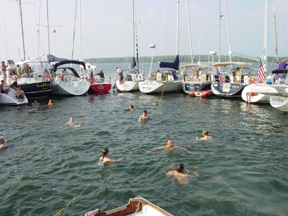Creating a sunflower raft-up
…here’s how one yacht club pulled it off.
Rafting up your boat with others can always be a fun experience, be it for cocktails, for dinner, to watch fireworks, or to spend the night, but the sunflower raft is perhaps the ultimate. Here is a brief description of how it is done. For more on tying up and rafting, check out our book on anchoring (and much more) Happy Hooking - the Art of Anchoring, where this and other techniques are discussed in more depth.
- Pick a sheltered location with good holding and little current on a calm day (we chose Dutch Harbor off Jamestown in Rhode Island). Assign someone primary responsibility to plan it out and give orders.
- Choose the largest vessel in the fleet and have them anchor first
- Make sure everyone is ready with dock lines and fenders either side.
- Choose a nimble vessel that backs well and can set a sturdy anchor in the opposite direction (i.e., anchor from the bow but stern toward the first vessel and the wind). Pass a nylon line between the sterns of the two primary vessels to keep them in line along the diameter of the circle. Estimate the diameter of the circle given the fleet size and adjust as boats are added. In our case, this was the person organizing the raft up; being both the first to anchor and last to close made it the ideal spot for him to observe and counsel from.
- Choose the next largest vessels and have them join the first anchored boat on either side. Have each of them set their anchors. They can do this by setting their anchors then dropping back to raft up, or they can raft up and someone in a dinghy can drop their anchors for them. (We had an inflatable dinghy helping out. We lowered our Fortress to them with a trip line that had a rope and buoy tied off. They basically dragged it with their dinghy as far as they could, given the weight of our chain rode, and then dropped it while we set it from our bow. We were happy to have the trip line as the anchor was well set when all was done.)
- Continue to add vessels either side and setting anchors about every third boat. As you add boats, you need to make sure the newly rafted boat drops back just a bit and keeps the bow looser than the stern or you will have a straight line rather than a circle. Set spring lines as well as bow and stern lines, and instruct everyone to watch their spreaders.
- As the circle closes, adjust the length of nylon line between the first two boats.
- Keep the smallest most nimble vessels for last. They will have to back into the circle.
- When the last vessel is in, tighten up the nylon line bisecting the raft up as you adjust the anchor rode for the boats on the downwind side.
- Arrange in advance for a helicopter to fly over when complete. Go swimming in the middle, go visiting around the circle, and enjoy cocktails on the flag officers’ decks. Remind everyone as a courtesy that the bow is where one crosses over rafted up boats as not to disturb activities in the cockpit. Break up before nightfall and have everyone re-anchor for a safe night.
This was one of the most memorable days and events of the cruise.
Left photo courtesy of www.riaerials.com
 |
 |
For more on tying up and rafting, check out our book on anchoring (and much more) Happy Hooking - the Art of Anchoring, where this and other techniques are discussed in more depth.
|